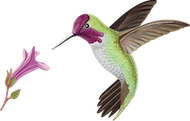As the Gottlieb Native Garden’s naturalist, Scott Logan documents the ever-changing array of wildlife species as they vary with the garden’s blooms, seasons and migratory patterns. While bringing these observations to life for all to experience, he also coordinates scientific research projects, and monitors the overall health and biodiversity of the garden. The Naturalist’s Journal also highlights the work the Gottliebs and Scott are doing to educate and inspire people to start gardening for wildlife with native plants.
Canine Cuteness!
This drain culvert in the lower back-garden is used by many animals as a convenient pathway. Deer, coyote, raccoons and skunks are among others caught on camera whilst out on leisurely day and night strolls. The star of these video captures at the moment is […]
Windy Morning at the Hummingbird Feeders
60 seconds of breezy zen…
Fall American Goldfinches
It’s so nice to have American goldfinches back in the GNG, even if they are now in their non-breeding plumage. Most people think of this bird as being bright yellow with an orange beak, but they are quite dull this time of year, not molting […]
Gotta’ Live With ‘em!
Lurking in most Los Angeles yards is the non-native Eastern fox squirrel, and the GNG is no exception. First introduced after WW2, this squirrel long-ago out-competed our native Western gray squirrel for the right to exploit a bounty of fruit from our trees and seed from […]
Afternoon Water Break
This popular fountain sees most of its action in the mornings, but still gets visitors throughout the day. On this afternoon, many species of birds came to drink or bathe – hummingbirds even had a few of their charming pool parties. Allen’s hummingbirds. House finch […]
Last Native Bee of the Season?
Native bees have not been seen in the GNG for a couple of weeks, until today. This lone sweat bee was noticed on one of the few buckwheat flowers in bloom in the garden. Native bees are active during specific times of the year and […]
A Struggle During Pollination
Milkweed flowers are unique in that unlike most flowering plants, the pollen of milkweed cannot be collected as individual grains. Instead, hundreds of pollen grains are packaged into pouches which need to be carried to another milkweed plant. How does this happen? Without getting too […]
Scaly-breasted Munias
Normally found in grassy areas along the L.A. River, finding scaly-breasted munia in the GNG was a nice surprise. They are known to wander post breeding season, and during this time will occasionally end-up at wild bird feeders. This was the first time seeing them in the […]
Painted Tiger Moth
Fall is the time in Southern California to look for this beautiful tiger moth. With its distinctive gray, wavy, patterned wings and bright orange body, it can be confused with no other. It’s during the late spring and summer months when their black haired caterpillars (nick-named […]
Gray Foxes in the Garden!
One of the GNG trail-cams caught some cuties recently – two Gray Foxes! This came as a surprise for two reasons. First, foxes have not been seen on the property in the past, despite that they inhabit the Santa Monica Mountains. Second, there is extensive construction in […]

